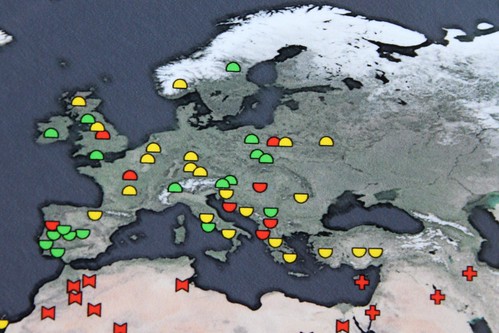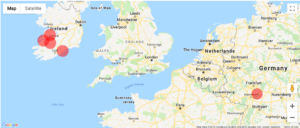Not too long ago I wrote a blog post about one of my distant relations who was somewhat infamous. This was something of a random topic for me. I just ran across the information online and was so entertained by it that I had to share.
I found out from this that I have a lot more Gerald relations than I even knew about, and I have always known it was a large family. I also found out that I have a whole lot of distant cousins researching the branches of our family tree.
Most specifically, there is a particular great-great-great-something-great grandfather of mine named James Gerald (father of Gabriel Gerald) who has become a sort of genealogical brick wall. We know who his son was, but we don’t know who his parents were. Some people think he came from Ireland. Others think he came from France. They at least think he came from people who came from either Ireland or France. It’s an enormous cousinly controversy, and we don’t have any concrete information in any direction to solve the question. Was James Gerald an Irish patriot who changed his name from Fitzgerald to Gerald somewhere along the way, or was he a French Huguenot? I don’t know.
I didn’t even know this was a question until a few weeks ago. I still don’t know the answer, but I do have something to add a little fuel to the fire.
One of my friends suggested a DNA profile for ancestry, and on an absolute whim, I sent off for a kit. I just got the results in the mail today.
I did this without doing any research on what kind of DNA test could tell us the most, and I ordered the results in map form, which probably seemed like a good idea at the time, but doesn’t make a whole heck of a lot of sense to me today. For you science people, it looks like what I have is a DNA STR profile, which has been matched against traits in populations around the world. The map supposedly shows where my genetic markers have the strongest matches to general populations.
My DNA matches were entirely European and European immigrant. This surprised me somewhat since I am certain of Native American ancestry on my mother’s side. What I don’t know about an STR is which ancestries it can match me to in the maternal or paternal lines. I’m hoping some science people do read this and take it upon themselves to enlighten me.
That said, if we have to answer the GGGGG Grandpa question based only on my DNA profile, my best guess would have to side with Ireland. I have a strong match to Ireland in my DNA and only a good match to France. Whatever that means.
Of course this doesn’t anything about where a specific ancestor came from. I have branches and branches of ancestry in all directions, and I still don’t understand the particular kind of DNA test that was done.
Regardless, here’s the European portion of my DNA map.
Green indicates a strong match. Yellow indicates a good match. Red indicates a weak match or no match.
For those of you who wonder what my Gerald connection is and whether my DNA counts as evidence in your own ancestral searches, my great-grandfather’s name was Albert Sidney Gerald, and he was the grandson of William Gerald, who was the son of Gabriel Gerald.
For those of you who understand what an STR DNA profile actually is and can tell me what kind of information I can learn about ancestry from it, please feel free to chime in. I would love for someone to explain the science to me. I am beyond clueless. All I know is that I’m not really all that French, but I am surprisingly much more Spanish than I ever knew.
Any guesses where that came from, cousinly people?
***
Addendum:
After pilfering around online a little, it looks to me as though the strong Spanish ancestry (when I know of no Spanish connections in my family) is actually even stronger evidence of Irish ancestry. Apparently there was an influx of Celtic people into Ireland by way of Spain at some point in history, and a large percentage of the population of Ireland tests as having strong DNA markers for Spanish ancestry — http://killarney-ireland.info/genealogy/dark-irish-celt-genealogy.html




Here’s an article about using DNA tests for Genealogy. It says that the STR profile is a composite profile of genetic markers from both the mother and the father — http://en.wikipedia.org/wiki/Genealogical_DNA_test#Types_of_tests
That doesn’t help much with telling whether a particular ancestor came from a particular location, but it is still interesting to see which populations my genes most closely match.